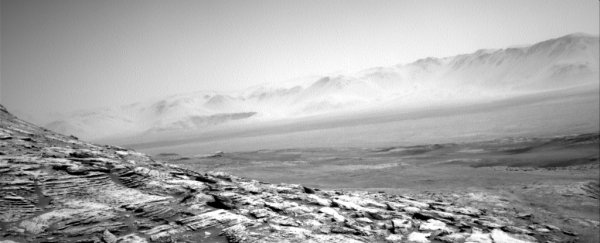Curiosity is climbing. In the Gale Crater it calls home, the Mars rover has been making its way up an eroded pediment called the Central Butte.
It's studying the weather-worn layers of rock around the base of Mount Sharp, which towers from the centre of the crater. But it's not just close-ups of rock that feature in the postcards Curiosity sends back to Earth.
In between staring at the ground, the rover also fixes its robotic eyes on the Martian horizon. The image above was taken using the rover's Right Navigation Camera B on November 1, or Sol 2573. It shows the view back towards the crater's edge.
In the foreground, the butte gently slopes towards the mountain. In the distance, the rim of the Gale Crater - created in a giant meteorite impact billions of years ago - rises from the dusty haze.
The image seems to drive home the sheer isolation of Curiosity's mission - after the sad shutdown of Opportunity, Curiosity is now the only rover operating on Mars (InSight is a stationary lander).
But the instrument has no time to be idle and contemplate its lonely fate.
 Central Butte photo taken 1 November or Sol 2572. (NASA/JPL-Caltech)
Central Butte photo taken 1 November or Sol 2572. (NASA/JPL-Caltech)
The Central Butte is deeply geologically interesting, with layers of sedimentary rock that hold clues to the region's water in the distant past. Curiosity will be studying these sedimentary layers to try to gauge their extent.
Curiosity's instruments are also investigating rock variations in the region - there are some different colours in the rock that suggest several stratigraphic units. Data taken by Curiosity will help to characterise these units, and how they may be related to each other.
The rover will also take images of a region at the top of the butte - too difficult for the rover to reach, but well within imaging distance.
"After all of these observations, Curiosity will start driving around the butte to look at it from the other side," wrote planetary geologist Kristen Bennett of the United States Geological Survey on NASA's Mars Exploration website.
"We expect to continue having amazing views of Central Butte at our next stop!"
